Journal of Modern Physics
Vol.3 No.4(2012), Article ID:18896,7 pages DOI:10.4236/jmp.2012.34042
Measurement Method of Graviton Velocity and Thought on Correcting Lorentz Transformation
——The Superluminal Neutrino’s Influence on Special Relativity and Other Physical Theories
Beijing, China
Email: luopingan6362@sohu.com
Received November 3, 2011; revised December 22, 2011; accepted January 13, 2012
Keywords: Special Relativity; Lorentz Transformation; Superluminal; Graviton; Measurement Method of Graviton Velocity; Singular Point; The Theory of Limited Universe
ABSTRACT
After discovery of the superluminal particle and consideration on development of contemporary physical theory research, also on the existing errors and omissions, the principle of constant light speed is found not a necessary condition in derivation of Lorentz Transformation; instead, this thesis proposes the velocity of graviton may feature superluminal, constant velocity in different directions, and independence of inertial reference frame speeds. This is an optional thought of correction. According serial hypothesis, an equation of graviton’s motion trace, i.e., the central curve of nebula density, is established for spiral galaxy. Thus we gain the method to measure velocity of graviton. If to totally avoid problem of limit speed, we have to search for independent of inertia frames, and relevant to space-time properties. Regarding current difficulties of singular points in the Theory of Limited Universe, this thesis points out that the document [1] is the best solution to these difficulties.
1. Introduction
As reported on websites [2,3] of Cornell University, USA and Nature, a British magazine on Sept. 22, 2011, European researchers have discovered the superluminal velocity of neutrino, a phenomenon unexplainable. T. Adam [2] reveals that:
1) Within a distance of 730 kilometers, the neutrinos are detected to travel 60 ns faster than light; in another word, neutrinos travel more 6 kilometers than light every second.
2) There is a relationship between travelling velocity and energy of neutrinos.
As per Einstein’s special theory of relativity popularly known, the speed of light is the limit of universal speeds, no any other speed can surpass light. So, if “Neutrino travels faster than light” is verified to be true, the classic theory of Einstein’s will be revised, or may be wrong.
2. Relation between Classic Physical Theories and Special Relativity
Scientists of the past generations have endeavored to draw plenty of physical laws from numerous experiments, which come together into a classic physical system, including dynamics, kinematics, electromagnetics, Newton’s law of universal gravitation, statistical physics, etc. Einstein had proposed the famous special theory of relativity in order to reveal physical laws between different inertial systems. When this theory was applied to study gravitational fields and the origin of universe, it developed to the theory of general relativity, a researching field high lighted until today. Their interrelation is shown as Figure 1, from which we can conclude that:
1) The earliest classic physical theories were mostly built on the basis of experiments. However accurately the experiment was performed, there must be errors; and just within these errors, infinitely minor quantities were ignored.
2) In order to solve the compatibility of physical theories between different inertial frames, Einstein introduced the presumption—speed of light is constant, by which he inferred the special theory of relativity, and reached a limiting conclusion: “Moving speed of any object can not overpass light”. If “Neutrino travels faster than light” can be verified as truth, Einstein’s theory special of relativity should be revised.
3) Theory of general relativity derived from special relativity hasn’t solved the problem of “limited universe” yet. Same as Newton’s law of universal gravitation, when people extended the application of this theory to limitless
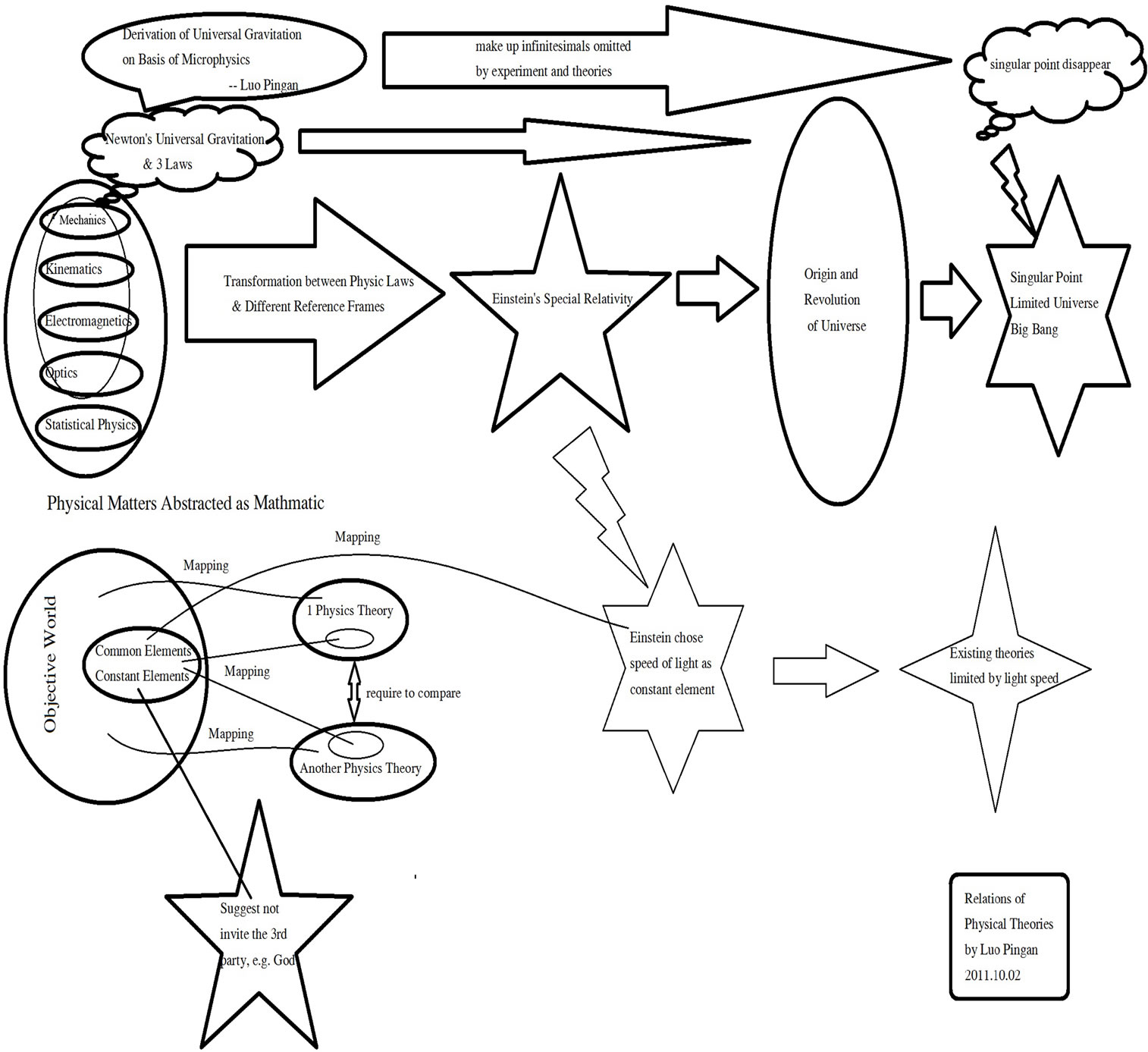
Figure 1. Correlations of physical theory.
space, they encountered the difficulty of singular point that gravity on each unit of surface area tends to be infinitely large [4], which results in presumptions such as the Big Bang, dark matter, etc.
4) My theory—“Derivation of Universal Gravitation Law on Basis of Microphysical Theory1” [1], is substantially to make up the infinitely minor quantities disregarded by other theories, then apply to limitless universe and naturally remove the difficulties of singular points encountered by Newton’s law of universal gravitation and theory of general relativity.
To make it clear, let’s regard this physical problem as a mathematic one. The objective world is a set itself, which can be mapped as another new set by some rules. And new physical theories can be created on the basis of these new set. Theoretically, these mapping can be infinitely, but not any random theory is excellent. One can evaluate a theory by referring to standards set by the document [5]. It must be a huge waste to study every mapping entirely. For the sake of cost saving, we must set up relations between sets for comparison. To set up the relations, we must find from different sets some common factors, which retain some invariant properties. To be objective, these special elements must be selected without dependence on the third party’s (the God’s, as I mean) observation.
During study of special relativity, Einstein regarded the constancy of light speed as a special element. But the problem is, not merely one element with this property, or constancy of light speed is not the property of the unique element. For example, sound velocity in air is constant— this is the same property of the special element. But beside, are there other special elements with the same property?
3. “The Speed of Light Is Constant” Is Not the Unique Precondition for Lorentz Transformation
To get insight into properties of above special elements, let’s review the classic deduction of Lorentz Transformation.
Supposed:
1) Principle of relativity is true; all inertial frames are equal, i.e., physical laws can be expressed in the same form for all inertial frames;
2) Space-time is homogeneous, i.e., all points in spacetime are equal, no superior point;
3) In any inertial frames, velocities of particle A are the same in different directions shot, and marked as vA;
Set up coordinates [6] as shown in Figure 2.
Step 1, to infer transformation of coordinates between the two inertial frames.
There are two inertial frames, one is K, another is K', they’re moving at a relative average velocity v (because movement is relative!). Their moving directions are respectively axis x and x', Ox and O'x' are coincide; Oy and O'y', Oz and O'z' are parallel. At the spot origin 0 of K and O' of K' fall together, both sides set their clocks to 0. That is, when, x = x' = 0, t = t' = 0.
As per presumption 2, one selection of origins 0 and O' is random; the other one is an “event” happens and the space-time coordinates (x', y', z', t') in Frame K' and the space-time coordinates (x, y, z, t) in Frame K are a linear relation (without quadratic dependence or other higher powers); by these two points, and axis y, z perpendicular to x, the movement only along x, we can get immediately
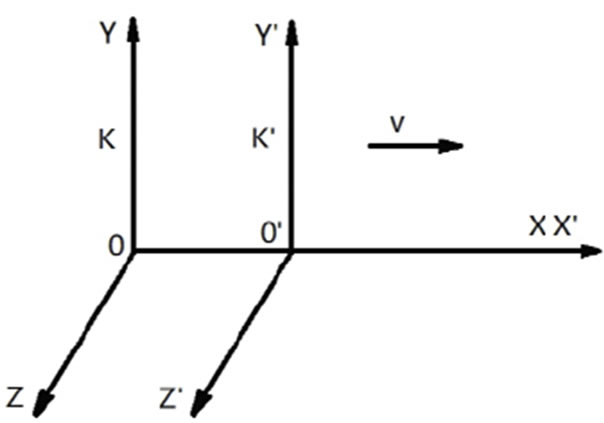
Figure 2. Interrelation of two coordinates.
 (3.1)
(3.1)
Linear relation between x', t' and x, t can be presented as:
 (3.2)
(3.2)
 (3.3)
(3.3)
To get constant multiplier coefficients a11, a12, a21 and a22, we must observe movement of origin O' in Frame K'. Viewed from Frame K', its coordinate ; but viewed from Frame K, O' is moving at speed v, i.e., its coordinate x = vt, or x/t = v, putting in formula (3.2), we get
; but viewed from Frame K, O' is moving at speed v, i.e., its coordinate x = vt, or x/t = v, putting in formula (3.2), we get
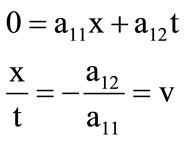
i.e.,
 (3.4)
(3.4)
Reputting in (3.2), we get general formula
 (3.5)
(3.5)
Step 2, determine coefficients a11, a21 and a22 in formulas (3.5) and (3.3) according to presumption 3.
We suppose the moment when origin 0 and O' coincide (i.e., t = t' = 0), a particle A starts from origin. View from Frame K, moving speeds of particle A along axis x (in forward or opposite direction) are still vA, so the point particle A reaches in coordinate x after a time t can be determined by following formula
 (3.6)
(3.6)
But viewed from Frame K', traveling speed of particle A along axis x' either in forward or opposite direction are still vA, so we have also
 (3.7)
(3.7)
Whatever objective space-time point particle A reaches, coordinate points in Frame K and K' are different,  ,
,  , but relations (3.6) and (3.7) always assure the validity of
, but relations (3.6) and (3.7) always assure the validity of
 (3.8)
(3.8)
Replace the left with (3.5) and (3.3)


Because the above is an identity (x, t are continuously variable, but above equation is always valid), coefficients of corresponding terms in the left and right must be equal; i.e.
 (3.9)
(3.9)
 (3.10)
(3.10)
 (3.11)
(3.11)
Derived from formulas (3.9) and (3.11) is
 (3.12)
(3.12)
 (3.13)
(3.13)
Multiplication of above two formula is

And derived from (3.10) is

Put in above formula


So
 (3.14)
(3.14)
Replaced that in (3.13), and we get a22. Put a11, a22 in (3.10), we get a21, then a12 from (3.4). Now we have
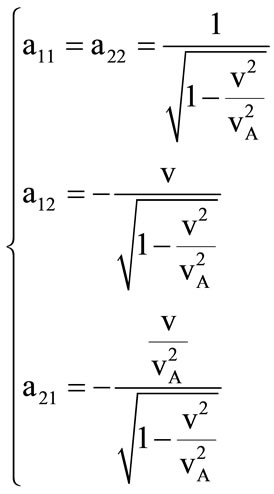 (3.15)
(3.15)
We insert the four coefficients in (3.2) and (3.3) to see
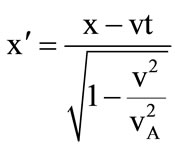 (3.16)
(3.16)
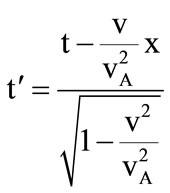 (3.17)
(3.17)
Formulas (3.1), (3.16) and (3.17) express the transformation of space-time coordinates in the two inertial frames where the “event” happening at the same objective space-time point is reflected.
In this transformation, it doesn’t acknowledge that Frame K is superior than K'. Inverse solution from (3.16) and (3.17) is
 (3.18)
(3.18)
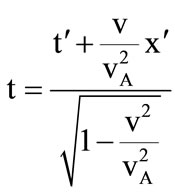 (3.19)
(3.19)
Obviously, above formulas and (3.16) and (3.17) are symmetrical, only replace v with (–v), because viewed from Frame K', Frame K is having a uniform motion at a speed v along axis –x'.
Objects conforming to requirement of presumption 3 consist not only in photon, but also sound wave for example, also with the same property.
If particle A is photon, then VA = c, the above result of derivation is Lorentz Transformation.
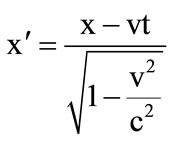 (3.20)
(3.20)
 (3.21)
(3.21)
 (3.22)
(3.22)
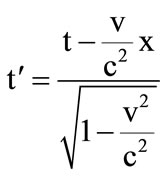 (3.23)
(3.23)
If the particle is phonon, its speed is vsound, then vA = vsound, above derivation should be
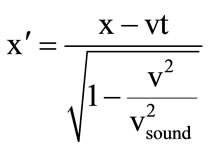 (3.24)
(3.24)
 (3.25)
(3.25)
 (3.26)
(3.26)
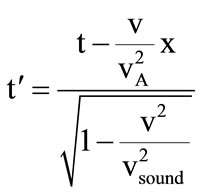 (3.27)
(3.27)
It’s evidently mistake to limit all velocities below vsound according to (3.24). Even though velocity (v) of relative movements of inertial frames is smaller than vsound, formulas (3.20), (3.23) and (3.24), (3.27) are different. When , formulas (3.20), (3.23), (3.24), (3.27) are approximately equal, otherwise the difference will be very evident.
, formulas (3.20), (3.23), (3.24), (3.27) are approximately equal, otherwise the difference will be very evident.
4. Velocity of Graviton May Be Far More Greater than Light
By above derivation, we discover that “principle of constancy of light velocity” is not the necessary condition in derivation of Lorentz Transformation. To determine coefficients in formulas (3.5) and (3.3), allowing velocity of particle greater than light at the same time, the simplest correcting plan is to find a particle with following properties:
1) It’s velocity is greater than light in vacuum;
2) In any inertial reference frame, it’s velocities shot in different directions are the same.
As per contemporary achievement of research, there are four basic acting forces in nature. As shown in Table 1, many properties of universal gravitation and electromagnetic force are similar. As for field quantum under strong force-gluon, it’s pointed out in the document [7] that in the 60 s of last century, Qian Sanqiang introduced wave function to describe moving hadron. By analysis of the experiment data, he proposed that velocity of straton moving in hadrons is far less than light, and it’s nonrelativistic. Under weak force, quality of field quantum W is 80.4 GeV, boson Z is 91.2 GeV, which is nearly 100 times of the quality of proton, and heavier than iron atom. Their velocities seemed less. Taking the second reason mentioned below into consideration, we may conclude that, velocity of field quantum is relevant to interaction range between it and other substance.
For solution of superluminal neutrino problem, we can predict that, among all discovered particles, graviton is one that mostly conform property requirements in derivation of Lorentz Transformation, because:
1) Universal gravitation and electromagnetic interaction are both long-range forces, and subject to reciprocal square law; some properties of graviton and photon are similar;
2) Unlike other interaction, universal gravitation can act extensively on all substance; in the reason of its extensive action, when quality of substance is infinitely large, properties and electric charge of the substance can be relatively omitted; this evidences that actual range of graviton may be larger than field quantum (photon);
3) Universal gravitation can go through tremendous astronomical body, yet its strength is far less than coulomb force, which means its action section on object is relatively small; the faster it moves, the time of interaction is shorter, and the action section is comparatively smaller; this also predicts that velocity of graviton is larger than light;
4) Laws of many forces are similar; since the property of photon—“In any inertial reference frame, the velocities shot in different directions are the same” exists both in air and vacuum, and graviton can go through any astronomical body and through the space easily, one can also predict the same property in graviton;
5) Among four basic forces discovered until today, range of gravitation is the longest, and its strength is the weakest; if strength of field quantum is relevant to its velocity, it’s known from Table 1 and former discuss, the smaller the range of action, the less the velocity of field quantum. One can also predict that velocity of graviton may be the fastest in all actual particles.
According to above inference, we suppose velocity of graviton is vgraviton,  , and replace particle A with graviton in former derivation. By derivation of Step 3, we can get a new Lorentz Transformation as following
, and replace particle A with graviton in former derivation. By derivation of Step 3, we can get a new Lorentz Transformation as following
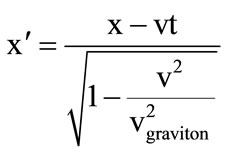 (4.1)
(4.1)
 (4.2)
(4.2)
 (4.3)
(4.3)
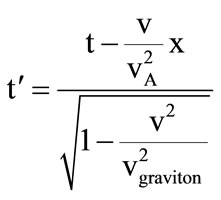 (4.4)
(4.4)
As a result, superluminal velocity of neutrino is adapted in the new system of theories, which is also compatible with the existing system in low-speed approximation. This is the most painless solution.

Table 1. Properties of four basic forces.
But theoretically, there’s still a problem—is vgraviton the limit of real particles? Is it the maximum? In the field of high speed, if velocity of particle is less than light, which transformation is more accurate? What is its application limit?
Taking formulas for Lorentz Transformation derived from sound speed and optic speed for example: viewed from Frame K, O moves at velocity v, we set t = 20 s, x = 10 m, vsound = 334 m/s, vlight = 299792458 m/s, now x' and t' vary with v. The calculation is shown as Table 2. The curve is as Figures 3 and 4.
Known from Table 2, Figures 3 and 4, even though v is less than sound speed and light, when v is near sound speed, x' and t' calculated by two formulas vary much with v. Then whick formula is more accurate? This cannot be judged by derivation. In the same reason, even though  is true, existing theories can not answer, when the velocity is less than light, which formula among (3.20)-(3.23) and (4.1)-(4.4) is the most accurate? And how is the accuracy? The answer should depend on verification of experiment.
is true, existing theories can not answer, when the velocity is less than light, which formula among (3.20)-(3.23) and (4.1)-(4.4) is the most accurate? And how is the accuracy? The answer should depend on verification of experiment.
5. Equation for Motion Trace of Graviton of Spiral Galaxy and Measurement Method of Graviton Velocity
Though it’s hard to detect graviton, we can find its effect everywhere, especially the distribution shape of nebula in the space, which is certain to be affected by its motion trace. Taking advantage of the astronomical observation, we try to complete measurement of graviton velocity, a tough task as it is.
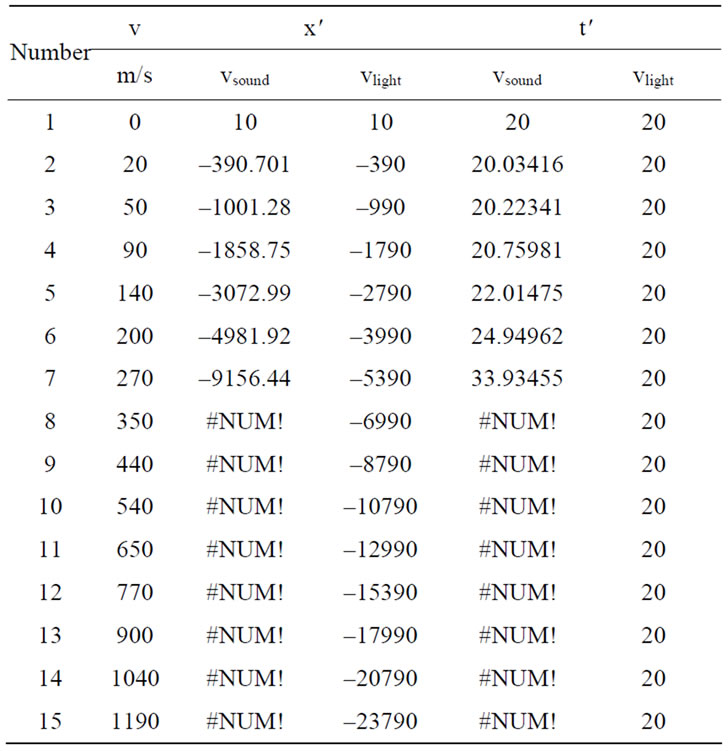
Table 2. Data of x' and t' Variation with v.
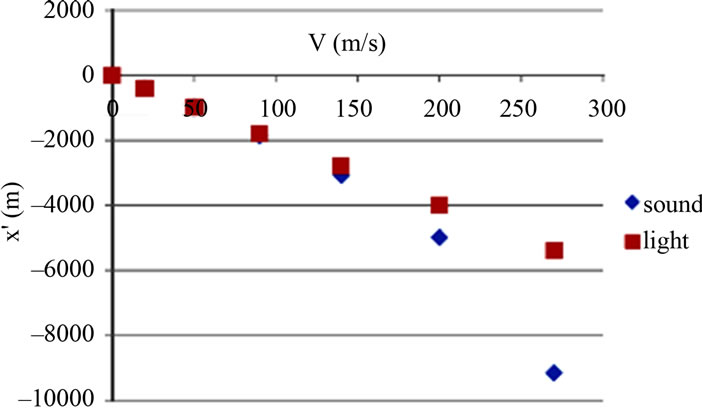
Figure 3. Varying Relation of x' and v in derivations of Lorentz transformation, by applying constant sound speed and speed of light.
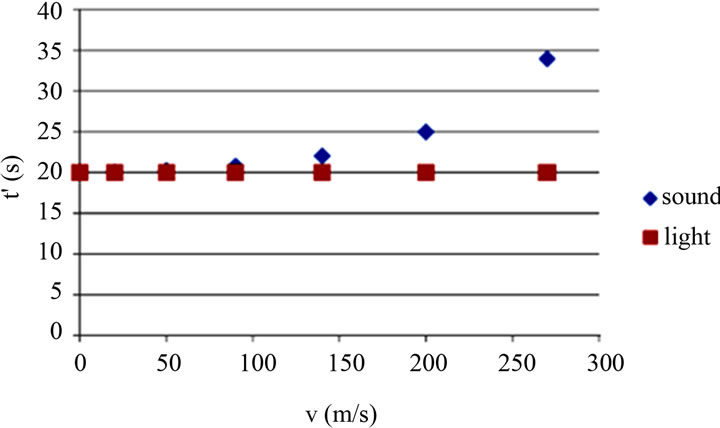
Figure 4. Varying relation of t' and v in Derivations of Lorentz transformation, by applying sound speed and constant speed of light.
Supposed:
1) In any inertial reference frame, the velocities of gravitons are the same in different directions shot.
2) Spin velocity of a spiral galaxy equivalent centrebody is w, radiant/s as its unit. Please be noted that there may be a plus or minus due to different direction of spinning axis.
3) In this spiral galaxy, gravitons launched outwards mostly come from centrebody of the galaxy and form main part of the galaxy’s gravitational field. Other stars are in this field.
4) Launching of gravitons are independent to each other.
5) Possible interaction between gravitons during their motion can be omitted.
6) In this galaxy, perpendicular lines between outerring stars along motion traces of gravitons are normal distribution.
Derivation:
Known from presumption 6, motion trace of gravitons is a curve formed in the stars with the uttermost density. Start angle of the spinning galaxy equivalent centrebody is assumed to be q0(radian), time of spinning is t(s), the largest distance between graviton and centrebody of galaxy is r(m), velocity of graviton is vgraviton(m/s). In system of polar coordinates, motion equation of gravity is as following
 (5.1)
(5.1)
 (5.2)
(5.2)
We get t from formula (5.1) and put in (5.2), then
 (5.3)
(5.3)
Formula (5.3) is the equation for motion trace of graviton and the central curve of density distribution of the galaxy.
From formula (5.3), velocity of graviton is solved as following
 (5.4)
(5.4)
By method of least square, formula (5.3) is fitted with the detected spiral galaxy data, so as to determine every parameter in the equation for motion trace of graviton, finally we get velocity of gravity vgraviton.
6. Solution of Lorentz Transformation Independent of Velocity Limit
Known from the third part of the derivation, if to determine three constants a11, a21 and a22 in formulas (3.3) and (3.5) disregarding presumption 3, we have to find three physical equations relevant to the coordinates and time, but constant in different inertial frame. This is another possible solution, and the unique free of the “velocity limit”. But it seems very difficult to find these physical equations satisfying the conditions. It’s impossible for conservation of mass, of energy, of momentum, and constant halflife ratio of radioactive elements.
Moreover, Professor Cao Shenglin with Beijing Normal University proposed a possible law: if without the velocity limit, it’ll be back to Newton’s idea of action at a distance, and other difficulties will also occur. Similar descriptions are found in the document [6].
As a result, it’s not easy to eliminate the “velocity limit”.
7. Elimination of Singular Point “Finite Boundary of Universe”
The singular point “Finite Boundary of Universe” is encountered in Newton’s universal gravitation and theory of general relativity. The essence is, all these theories ignore the infinitely minor quantities, which results in sum-up of the infinitely minor quantities tending to infinitely great. Conclusion by the document [1] eliminates the difficulty of singular point encountered by Newton’s universal gravitation and theory of general relativity. The physical essence is to make up omitted infinitely minor quantities, with this extended to the infinite space, sumup of the infinitely minor quantities tend to be infinitesimal, which eliminates difficulty of singular point encountered by Newton’s universal gravitation and theory of general relativity.
8. Summary
European researchers’ discovery of unexplainable superluminal neutrino has disclosed the defects of existing main theories. There are two great difficulties for these theories—velocities of all particles cannot overpass light; singular point leading to “limited universe”. This thesis focuses on solution of the first difficulty, and the document [1] solutes the second.
9. Acknowledgements
Beijing Sodality of Relativity has provided a platform for scientific innovation, and taken great effort herein. President Wu Shuiqing and many experts, staff have given strong support to my work. Professor Cao Shenglin with Beijing Normal University has given many valuable advices. For all these people and their help, I hereby express my sincere gratitude!
REFERENCES
- P. A. Luo, “Derivation of Universal Gravitation on Basis of Microphysics,” Matter Regularity, Vol. 11, No. 46, 2011, pp. 20-30.
- T. Adam, N. Agafonova, et al., “Measurement of Neutrino Velocity with the OPERA Detector in the CNGS Beam,” 2011, http://arxiv.org/abs/1109.4897.
- G. Brumfiel, “Particles Break Light-Speed Limit,” 2011. http://www.nature.com/news/2011/110922/full/news.2011.554.html
- A. Einstein, “Relativity the Special and the General Theory,” Methuen & Co. Ltd., London, 1955.
- P. A. Luo, “Evaluation Standard for Schools or Theories,” 2011. http://blog.sina.com.cn/s/blog_4bd628330100uze0.html
- G. J. Ni and H. F. Li, “Modern Physics,” Shanghai Science and Technology Publisher, Shanghai, 1979, pp. 38- 43.
- “Hadron—Physics Term.” http://baike.baidu.com/view/2380.htm
NOTES
1There are some printing errors in this document. One can find out these errors by context understanding, but I still appologize for my imprudence, and ask for reader’s attention to the errors:
1) In formula (1), dr" easily confused with derivative marks, is omitted during modification. The correct one should be dr2 .
2) In formula (3),  is wrong copied, it should be corrected as g(Rm), followed by Taylor Expansion.
is wrong copied, it should be corrected as g(Rm), followed by Taylor Expansion.

